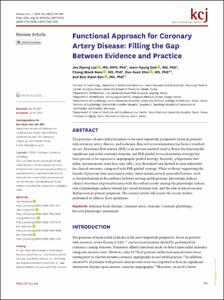KUMEL Repository
1. Journal Papers (연구논문)
1. School of Medicine (의과대학)
Dept. of Internal Medicine (내과학)
Functional Approach for Coronary Artery Disease: Filling the Gap Between Evidence and Practice
- Keimyung Author(s)
- Nam, Chang Wook
- Department
- Dept. of Internal Medicine (내과학)
- Journal Title
- Korean Circulation Journal
- Issued Date
- 2018
- Volume
- 48
- Issue
- 3
- Keyword
- Coronary artery stenosis; Coronary physiology; Invasive physiologic assessment; Ischemic heart disease
- Abstract
- The presence of myocardial ischemia is the most important prognostic factor in patients with coronary artery disease, and ischemia-directed revascularization has been a standard of care. Fractional flow reserve (FFR) is an invasive method used to detect the functionally significant epicardial coronary stenosis, and FFR-guided revascularization strategy has been proven to be superior to angiography-guided strategy. Recently, a hyperemia-free index, instantaneous wave free ratio (iFR), was developed and showed its non-inferiority for clinical outcomes compared with FFR-guided strategy. While evidence supporting the benefit of pressure wire assessment exists, there remain several unresolved issues, such as the mechanism of discordance between resting and hyperemic physiologic indices, clinical outcomes of patient/lesions with discordant results among the physiologic indices, role of physiologic indices beyond per-vessel decision tool, and the role of microvascular dysfunction in patient prognosis. The current article will review the recent studies performed to address these questions.
- Keimyung Author(s)(Kor)
- 남창욱
- Publisher
- School of Medicine (의과대학)
- Citation
- Joo Myung Lee et al. (2018). Functional Approach for Coronary Artery Disease: Filling the Gap Between Evidence and Practice. Korean Circulation Journal, 48(3), 179–190. doi: 10.4070/kcj.2017.0393
- Type
- Article
- ISSN
- 1738-5520
- Appears in Collections:
- 1. School of Medicine (의과대학) > Dept. of Internal Medicine (내과학)
- 파일 목록
-
-
Download
 oak-2018-0518.pdf
기타 데이터 / 1.73 MB / Adobe PDF
oak-2018-0518.pdf
기타 데이터 / 1.73 MB / Adobe PDF
-
Items in Repository are protected by copyright, with all rights reserved, unless otherwise indicated.